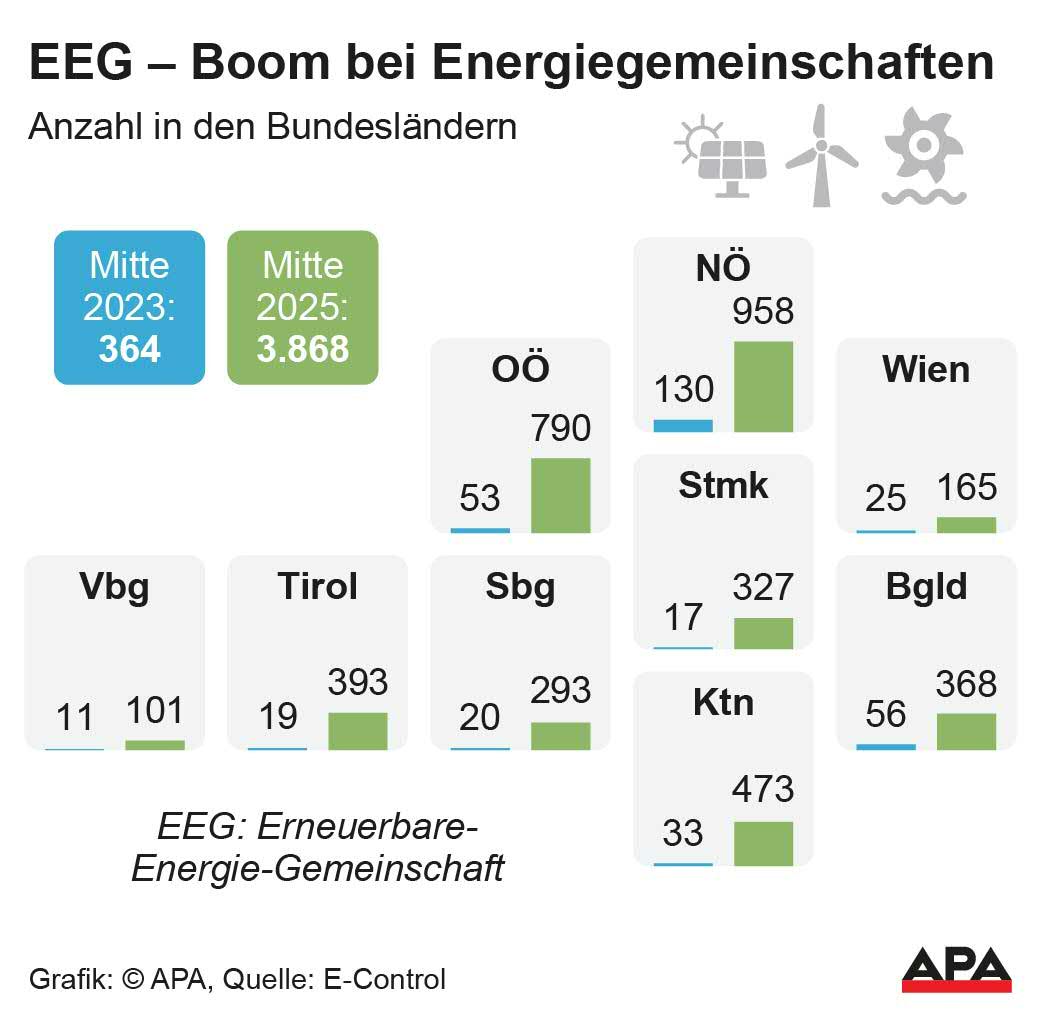Boom in Electricity from Renewables Continues

"Overall, one can say that the EAG is effective," said E-Control board member Wolfgang Urbantschitsch during the presentation of the monitoring report. Due to the structural changes in the funding landscape brought about by the Renewable Expansion Act, the need for subsidies has also decreased.
Electricity from Renewables: It's Not Possible Without Subsidies
The figures are overall pleasing, said Urbantschitsch. The EAG has brought about a regime change. While previously, under the Green Electricity Act, every amount of electricity generated was subsidized based on feed-in tariffs - "regardless of whether the amount was needed at the time or not" - a market premium model was introduced with the EAG, explained Urbantschitsch. In 2024, a total of 3,092 GWh was subsidized through the EAG market premium, based on 1,897 MW of installed capacity - predominantly wind (883 MW) and PV (804 MW). A total of 115 million euros was paid out for this. In the market price balance group, accepted quantities increased from 1,478 to 1,664 GWh; capacity increased from 2,405 to 2,497 MW.

It will not be possible to do without subsidies, said Urbantschitsch. "However, this always depends on the individual categories of installations. For a small photovoltaic system, it will probably no longer be necessary to subsidize it, at least not to the same extent." If subsidies are provided, they should be combined with simultaneously installed storage and with the obligation to use these storage systems in a system-friendly manner. The subsidy costs for end customers remained subdued: in 2023, the renewable subsidy contribution was 0 cents/kWh, and in 2024, the subsidy contribution and flat rate were financed from the federal budget. In 2025, households will pay an average of around 60 euros for renewable subsidies. For low-income households, a cap of 75 euros per year would apply.
Targets for Renewable Expansion Are Achievable
The monitoring highlights the target paths of the Renewable Expansion Act (EAG): a balance of 100 percent renewable electricity by 2030, an additional 27 terawatt-hours (TWh) of generation from renewables, and 5 TWh of renewable gas in gas sales. In photovoltaics, we are above the expansion path, explained E-Control board member Alfons Haber. In wind power, hydropower, and biomass, we are below the annual average expansion paths. However, it is assumed that the necessary grid connections will be available in the coming years and that more wind power connections will be added. "Currently, we assume that the additions for the 27 terawatt-hours by 2030 are possible."
Electricity Generation from Renewables Increased
After a slight increase in consumption, gross electricity generation - including pumped storage - has recently increased significantly. The competitive situation in the electricity market has also improved after the energy crisis, according to Haber. Gross electricity generation, including pumped storage, reached 70,861 gigawatt hours (GWh) in 2024. The installed renewable capacity was expanded by a net 7,906 MW compared to 2020 (excluding pumped storage), and the generated renewable quantities increased by 12,241 GWh - fluctuating significantly depending on the year of water, wind, and sun.
Around 3,900 Energy Communities
The model of energy communities has grown significantly: While there were only 364 Renewable Energy Communities (EEG) in operation in mid-2023, by the end of 2024 there were already 2,618 and by mid-2025, 3,868 - with the largest growth recorded in Lower Austria and Upper Austria. Additionally, 2,130 MW of PV and 196 MW of wind were newly installed in 2024. Based on past experiences, the legal foundations for energy communities now need to be adapted and clear regulations found in other areas, said Urbantschitsch. Timely and accurate billing data is particularly important for energy communities. However, although the smart meter billing is complete, data is not always 100 percent available. "In this area, the ElWG amendment should have provided the necessary clarifications," Urbantschitsch regrets the still missing law.
Lag in the Target for Renewable Gases
There is still a significant lag in the target for renewable gases: In 2024, fewer renewable gases were fed into the grid. Due to the decreased gas consumption, the share was still 0.16 percent. For more dynamism, in addition to the pending Renewable Gas Act, a long-term strategy for the demand and use of gases is needed, emphasized Urbantschitsch. It has been shown "that potential plant builders are still waiting for the Renewable Gas Act." Looking ahead, E-Control speaks of a statistical peak in renewables - at the same time, the strong expansion in summer brings oversupply and negative prices. Key factors are storage, flexible loads, and short-term markets, as well as the rapid expansion of the grid.
Hattmannsdorfer: Energy Crisis is Over
"The report clearly shows: Austria is on the right track," said Minister of Economic Affairs Wolfgang Hattmannsdorfer (ÖVP) in a response. "We have left the energy crisis behind and made the location more competitive step by step. The expansion of renewables is in full swing." Ulrich Streibl, CEO of oekostrom AG, expects further expansion in photovoltaics. "Where we have expanded little is in the area of wind power. And that is indeed a problem. Photovoltaics is a summer power source, wind power is the winter power source. And in winter we have too little renewable electricity in Austria. That means we are dependent on imports. Imports are mostly coal power from Germany or Poland, or nuclear power from France. If we want to be independent in Austria, then we must primarily expand wind power to have renewable electricity in winter," said Streibl in the Ö1 midday journal.
(APA/Red)
This article has been automatically translated, read the original article here.
Du hast einen Hinweis für uns? Oder einen Insider-Tipp, was bei dir in der Gegend gerade passiert? Dann melde dich bei uns, damit wir darüber berichten können.
Wir gehen allen Hinweisen nach, die wir erhalten. Und damit wir schon einen Vorgeschmack und einen guten Überblick bekommen, freuen wir uns über Fotos, Videos oder Texte. Einfach das Formular unten ausfüllen und schon landet dein Tipp bei uns in der Redaktion.
Alternativ kannst du uns direkt über WhatsApp kontaktieren: Zum WhatsApp Chat
Herzlichen Dank für deine Zusendung.








